Learning from Experience.
Why is it that we can’t just “download” the instruction manual that was built from the blood, sweat and tears of those who have learned before us? Sigh. It’s just the way of the world, I guess.
Sometimes learning comes from that ‘first hand, landing in the middle of stuff’ experience. Other times it comes from watching others…what works and what doesn’t? From the asking: can I apply that to my own situation?
So, here’s what brought this on:
I recently went to my first trial of the year, over the 4th of July weekend. I know…that’s hard for me to believe too! The last trial I went to was last October. Geez! First we had spring lambing, crazy mud and flooding, then we had a beautiful litter of border collie puppies…the couple of trials I had planned on for the spring didn’t work out…and then it was July!
The trial was at Joni’s in western North Dakota, so that’s a 2200 mile round trip for me to have the opportunity to discover that none of my dogs were able to stay connected to me in the very distracting and unrehearsed conditions of running 3 range ewes in 18 inch grass growing in the hills of the high plains where it was blazing hot and the 20 mph wind in my face felt like a blast furnace. Whew.
Did I say how very challenging that was? You know it’s tough going when only 25% of the open class gets a score and a 41 makes the money. Really tough.
 Slash J trial field
Slash J trial fieldThe reason I drove out there was for experience. To learn. For me and my 3 young Open dogs to learn about handling such things. I have to admit that I thought we would do a bit better than we did. After all, last year we ran in the very challenging Slash J and the nearly impossible The Big One, and all my dogs did respectably – I was so pleased with their learning last year.
In retrospect, I can’t imagine why I thought we would do better…quite illogical, really!
Considering that none of my dogs had any trial/precision type of work at all…Sue hadn’t worked for three months, being a busy mom…Maya had dislocated a toe and hadn’t worked in a month…and Luc, who was the dog that “finished” the courses at last year’s ND trials at the tender age of 3, at his 2nd Open trial…had been doing farm chores, helping with lessons, moving ewes and lambs but definitely not partnering with me with the precision and finesse required of being competitive at trials. Plus…those ND trials were over a year ago…and our last trial was eight very l-o-n-g months ago.
So: We did not bring home any ribbons or points, not even close. But. All three of the dogs showed much improvement the 2nd day, so I was pleased. And. I did bring home some valuable lessons.
Three Lessons Learned…
Lesson #1. Listening is sometimes hard, even for good listeners.
At the July ND trial, what hit home loud and clear was that not only were we out of practice and inexperienced at handling tough western trials…but that I had not done a good job at teaching my dogs to “listen” to me when they are in the midst of very challenging work. In review, I could see in my mind’s eye all the times that same issue showed up at home as we trained or did chores. Yep. Clear as day.
The Solution: pay attention to my dogs when we are working…I mean: real, focused, watching the details attention. Help them to listen during the times when they might become engrossed in the sheep, the task, the conditions. Change things up more frequently in our work. Avoid routine work which leads to inflexibility and dull thinking in me and my dogs.
Be impeccable in my handling and training, which will help my dogs to listen better. Set up work that is very challenging so that we can practice staying connected during the challenge. Stay calm and communicate with helpful clarity to my dogs. Be sure we are rehearsing good moves. When I am a good listener and paying attention to my dogs, seeing when they need my help…I am automatically nurturing good listening from my dogs.
Lesson #2. Know when to get off the field and how to do it.
This lesson comes from both from my own past experiences running my young dogs and from observing what happened at this trial for other teams. There seems to be a lot of “run up the field, chase your dog off and wield your stick in a threatening manner” at trials these days.
First off: it’s against the rules. “No training allowed at a trial, so don’t ever run up the field at your dog, it’s inappropriate” — that’s what I was taught by my mentors. I’m using the term “training” loosely here, I know. Training in my world doesn’t look or feel anything like that.
Secondly: it doesn’t work. Think about it. You have seen the same people repeat the same behavior over and over again with the same and different dogs over the years. If it worked, they wouldn’t have to keep doing it. There are exceptions, but I prefer not to even think about why that works for some people.
The Solution: First, be as sure as you can that your dog is ready to trial. That said, dogs sometimes get over their head at a trial, and that WILL happen if you trial young dogs. And when that happens, my responsibility is first and foremost to the sheep. Keep them safe and do not harass them. Then, I am responsible to my dog and for the experience I am creating for that impressionable young dog.
So…I try my best to stay calm.
I try to remember that yelling, screaming and frantic running at my dog will only cause a dog to be more excited, frantic and far less likely to listen to me.
My dog is NOT being “bad”, it’s just over it’s head. I did not do my job of preparing my dog well enough. My bad.
So, I calmly, quickly and quietly move toward the sheep with the intention to protect them and to help my dog get the sheep under control, which in turn will help me get my dog under control.
That’s what I was taught: if you control the sheep, you can control the dog. It’s all about the sheep. So, I calmly and firmly ask my dog to lie down when I am near the sheep.
Then, I assess what to do next. Can we remove the sheep from the field calmly and under control, as partners? If yes, proceed. If not, I call my dog to my hand, attach the leash that I always have in my pocket when I’m working young dogs, and ask for help in removing the sheep from the field. This solution helps everyone: the sheep, the trial host, your dog, and you – because you were able to share a LEARNING experience with your dog.
Some of our best work has been done taking sheep off the trial field at the end of a rushed and frantic fetch, and I know that work helped us at future trials. If we could NOT do that task, then our partnership was not damaged at all, nor did I create a situation where my dog thinks “bad things happen at trials”, but instead sees that I am the same calm handler at a trial and I interrupt frantic behavior immediately…and that is useful too.
Lesson #3: Integrity, Sportsmanship and Good Example are the responsibility of Open Handlers.
Well…everyone really, but most definitely open handlers. It’s a tall order.
Sometimes we don’t feel like we are capable, competent and able to be responsible for such things. Or maybe don’t have to be. Especially when we first wear the ‘open handler’ cap.
But, it’s not an option. It’s a requirement…a sort of contract that we sign when we choose to send in our first entry in “Open”.
Young, inexperienced, novice and pronovice handlers are watching what we do and how we do it and they are imitating us.
The general public, local farmers and ranchers are watching what we do and how we do it and are either appalled or enthralled.
I witnessed and was involuntarily exposed to one of the worst cases of inappropriate behavior I’ve ever seen, at this trial.
While walking my young dog out to the ‘waiting in the hole’ area, a handler before me was trying to leave the field and began chasing their dog, violently yelling and making threats with their stick while the dog was desperately and frantically trying to escape from the handler…and the worst of it was that this violent display unfolded right around me and my dog and most definitely effected both of us greatly. Wow.
The Solution: It’s simple really. I try to remember to always behave as if someone I hold in high regard is watching me. Everywhere. All the time. Because, really, someone is.
Maybe it’s ‘just’ my dog (who, yes, I hold in the highest regard)…and I am ashamed when I see myself mirrored back to me through my dog’s expression with anything but love, respect, curiosity, contentment or happiness.
If you find yourself behaving badly, interrupt that immediately, apologize to those you have affected (including your dog) and see what you can do about making things right.
Lessons from Real Life Experiences…
So…I ask myself: are these lessons worth the 2200 miles and time spent? I do believe so.
One thing is for certain…1100 miles home is a long time to think about things.
Are You Training Your Way to Herding Trial Failure?
You might like to read this article I wrote all about that!!

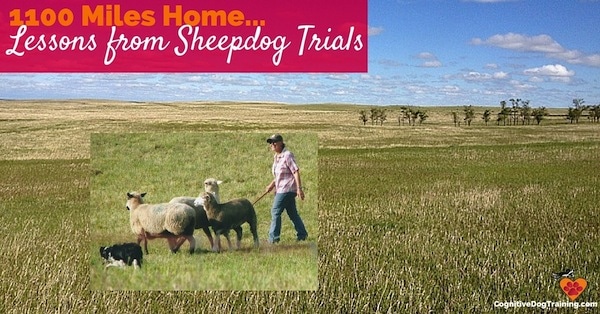
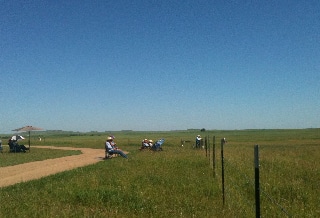
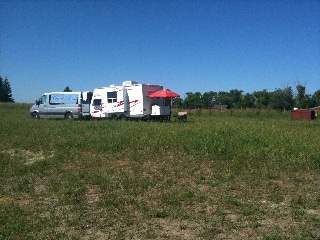
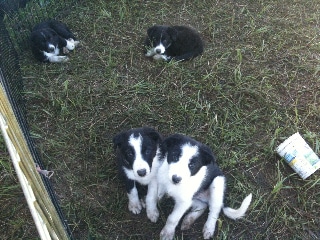


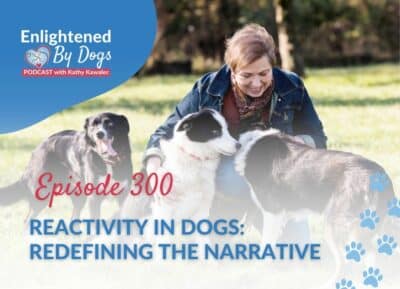

4 Responses
Sometimes frustration takes over in our dogs and in us. I recently had this happen at trials in Colorado. The sheep were quite miserable and both of my dogs were a bit over tasked. There was a lot of yelling and threatening, but in the end both had come a long way from the year before when neither made it around. The second day, the old dog actually had a very good run and should have not only qualified but been high. Sadly, the judge had little experience and didn’t understand what correct independent tending actually looks like. But trialing in unknown situations always gives me ideas of how to improve my training and find out exactly where my dogs are in relationship to not only the sheep, but also their training and our relationship. Trialing in your backyard does not give you that kind of reality check.
So true. Taking it on the road shows us all the things we need to work on!
So when the dog is wildly racing the sheep off the lift, how do you control the sheep ?
well, you can’t control sheep if the dog is chasing them out of control and you are far away from them. I think that’s what you mean?
So, what I would do (have done with young dogs) is to leave the post, quickly and quietly move toward the sheep and dog, to meet them. Then, when I am within range, I would then be able to use clear body language, communicate with my dog (and the sheep) to slow/stop.
From there, we might be able to try to exhaust the sheep. If not, I would signal to the exhaust person to assist while I collected my dog.
What I would NOT do is to run up the field, screaming at my dog and behaving in a frantic or threatening manner.